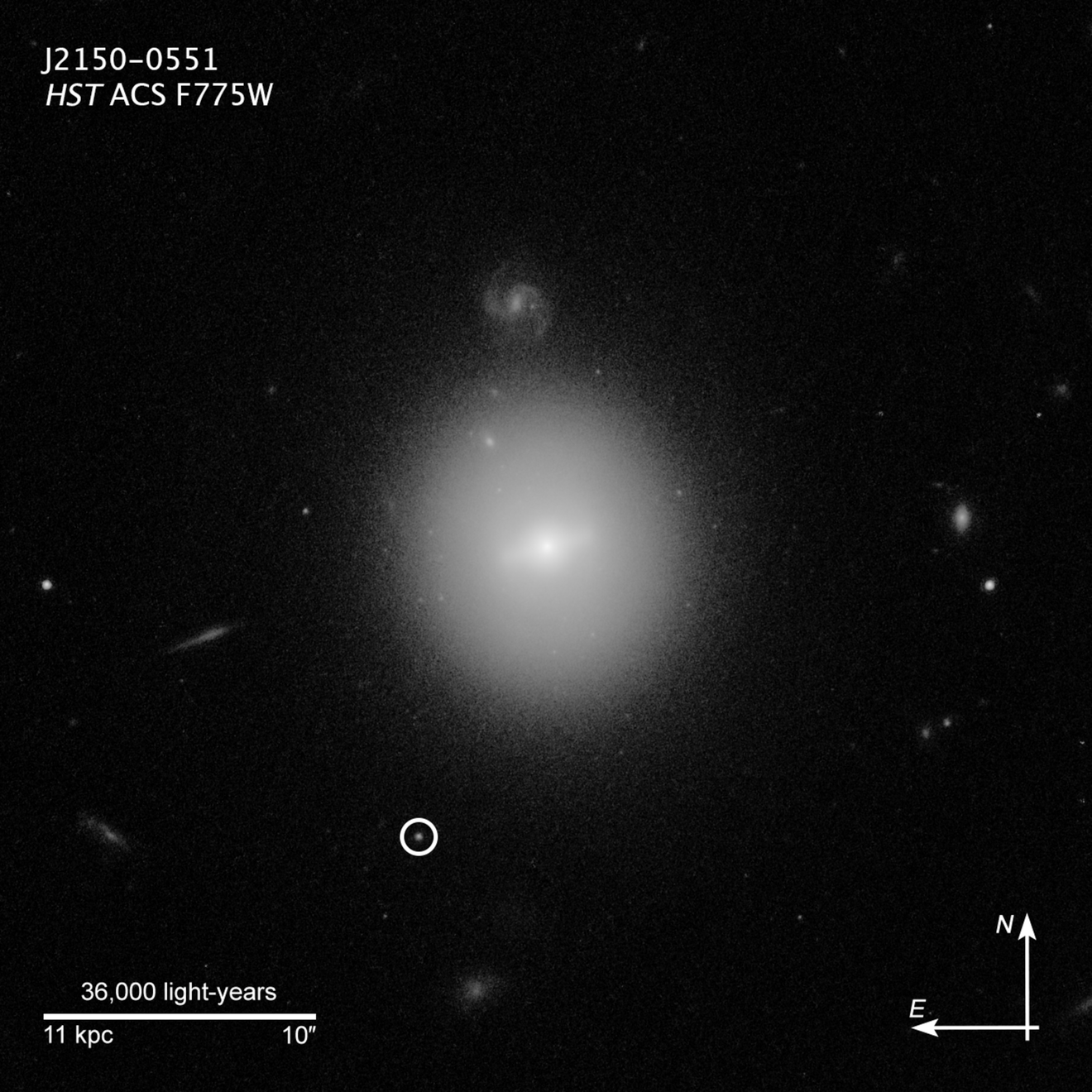1 min read
J2150-0551

Hubble Locates Intermediate-Mass Black Hole
This Hubble Space Telescope image identified the location of an intermediate-mass black hole, weighing over 50,000 times the mass of our Sun (making it much smaller than supermassive black holes found in the centers of galaxies). The black hole, named 3XMM J215022.4−055108, is indicated by the white circle. The elusive type of black hole was first identified in a burst of telltale X-rays emitted by hot gas from a star as it was captured and destroyed by the black hole. Hubble was needed to pinpoint the black hole's location in visible light. Hubble's deep, high-resolution imaging shows that the black hole resides inside a dense cluster of stars that is far beyond our Milky Way galaxy. The star cluster is in the vicinity of the galaxy at the center of the image. Much smaller-looking background galaxies appear sprinkled around the image, including a face-on spiral just above the central foreground galaxy. This photo was taken with Hubble's Advanced Camera for Surveys.
About the Object
- R.A. PositionR.A. PositionRight ascension – analogous to longitude – is one component of an object's position.21:50:22.457
- Dec. PositionDec. PositionDeclination – analogous to latitude – is one component of an object's position.-05:51:09.163
- ConstellationConstellationOne of 88 recognized regions of the celestial sphere in which the object appears.Aquarius
- DistanceDistanceThe physical distance from Earth to the astronomical object. Distances within our solar system are usually measured in Astronomical Units (AU). Distances between stars are usually measured in light-years. Interstellar distances can also be measured in parsecs.About 800 million light-years
- DimensionsDimensionsThe physical size of the object or the apparent angle it subtends on the sky.Image is about 40 arc seconds across (about 155,000 light-years)
About the Data
- Data DescriptionData DescriptionProposal: A description of the observations, their scientific justification, and the links to the data available in the science archive.
Science Team: The astronomers who planned the observations and analyzed the data. "PI" refers to the Principal Investigator.The HST observations include those from program 15441 (D. Lin) - InstrumentInstrumentThe science instrument used to produce the data.ACS/WFC
- Exposure DatesExposure DatesThe date(s) that the telescope made its observations and the total exposure time.May 24, 2018
- FiltersFiltersThe camera filters that were used in the science observations.F775W
- Object NameObject NameA name or catalog number that astronomers use to identify an astronomical object.J2150-0551
- Object DescriptionObject DescriptionThe type of astronomical object.Intermediate Mass Black Hole
- Release DateMarch 31, 2020
- Science ReleaseHubble Finds Best Evidence for Elusive Mid-Sized Black Hole
- Credit

These images are a composite of separate exposures acquired by the ACS/WFC instrument on the Hubble Space Telescope. In this case, the monochromatic image is presented in grayscale.

Related Images & Videos

Illustration of Black Hole System
Illustration of Mid-Sized Black Hole Eating a Star This artist's concept depicts a cosmic homicide in action. A wayward star is being shredded by the intense gravitational pull of a black hole that contains tens of thousands of solar masses. The stellar remains are forming an...
Share
Details
Claire Andreoli
NASA’s Goddard Space Flight Center
Greenbelt, Maryland
claire.andreoli@nasa.gov





























